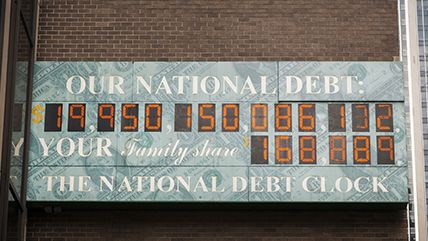The Cost of Carrying Debt
Low interest rates ease the pain of carrying so much debt. But in the long run, somehow, the U.S. will end up paying for it.

Sometime in 2017, the total U.S. national debt will hit $20 trillion—more than the total gross domestic product (GDP) of the country in a year. That figure is projected to keep growing over time, thanks to rising annual deficits. Debt held by the public, a measure that counts all federal securities sold to individuals, corporations, and state and local governments, plus foreign investors, currently clocks in around $14 trillion. That figure is expected to hit $23 trillion in 2026.
There are risks to carrying a debt burden this big. It increases the nation's susceptibility to a fiscal crisis if interest rates rise, and it limits the sorts of projects government can take on in a constrained fiscal environment. The greater the debt, the greater these risks become.
One of the biggest drawbacks of a high debt load is the cost of paying interest, which is currently one of the largest spending categories in the U.S. budget. At $241 billion last year, debt service—which buys the country nothing except a continuation of its debt—is effectively a program unto itself.
Although today's unusually low interest rates aren't likely to return to historic norms anytime soon, they are expected to increase over the coming years. That means that interest payments will go up too. Indeed, according to a December report by the Committee for a Responsible Federal Budget, relying on data from the Congressional Budget Office and the Treasury, spending on interest payments will rise faster than any other program over the next decade, jumping 196 percent. In comparison, military spending, Social Security, and health care programs are expected to increase by 24, 77, and 78 percent, respectively.
That means that without policy changes, debt service payments will almost triple to $712 billion by 2026, and they will double as a share of the economy to 2.6 percent of GDP. Over the same time frame, about three-quarters of the expected increase in the budget deficit—the yearly gap between the government's spending and revenues—can be explained by the rising cost of those interest payments.
All of this depends on how interest rates change. They aren't expected to spike, but if they did, the consequences would be severe. If rates are even a single percentage point over projections, total debt will be $1.5 trillion higher over a decade.
Low interest rates ease the pain of carrying so much debt. But in the long run, somehow, the U.S. will end up paying for it.
This article originally appeared in print under the headline "The Cost of Carrying Debt."


Show Comments (30)